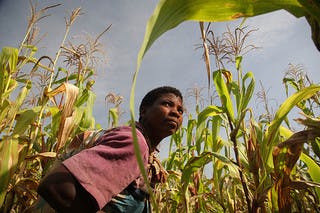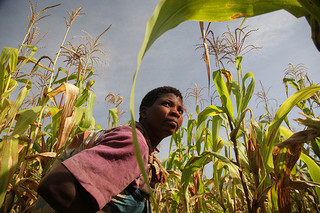Closing the gender gap in agriculture: Increase women's access to agricultural services and boost farm production
Jan 21, 2015
First story


According to the Food and Agriculture Organization (FAO) 2010-11 State of Food and Agriculture report on women in agriculture, women comprise an average of 43% of the agricultural labour force in developing countries. In sub-Saharan Africa, more than 60% of employed women work in the agricultural sector, and most are smallholder farmers practising mixed crop-livestock farming on small farms of less than one acre and keeping one or two dairy cows.
Studies have shown that there exists a gender gap in agriculture. There are differences in yield between male and female farmers, not because the women farmers are less skilled than their male counterparts but because women are constrained by lack of access to agricultural inputs and resources. Women farmers also have less access to credit facilities because they often lack collateral that would enable them take loans to improve their farming businesses.
There is valid reason to improve women’s access to services and technologies for agricultural production because empirical evidence shows that if rural women in developing countries had the same access to land, technology, credit, education and markets as men did, yields on women’s farms could be increased by 20-30%. This would result in an increase in agricultural production in developing countries by 2.5-4% which could in turn reduce the number of hungry people in the world by 12-17%, or 100-150 million! If ever there was a time to close the gender gap in agriculture, especially smallholder agriculture in sub-Saharan Africa, that time is now.
We need to close the gender gap in agriculture and increase the access of rural women farmers to various resources including technologies for livestock breeding and animal feeds; extension services; improved seed varieties; credit facilities and market information. However, any proposed actions need to take into account gender differences because men and women farmers are likely to be impacted differently by policies and institutions.
Consider, for example, the findings of a February 2012 study by scientists at the International Livestock Research Institute that assessed how women’s access to livestock information and financial assets compares to that of men among male-headed households in four districts in Kenya where the agricultural sector contributes 26% of the national Gross Domestic Product and provides a livelihood to over 80% of the population.
Informal channels of sharing information through farmer-to-farmer interactions were generally more important sources of information on livestock production and marketing than government extension services or radio, and female farmers relied more on the farmer-to-farmer exchange of information compared to the male farmers.
The study noted that agricultural training sessions were available within the villages but the sessions were held far away from the home. Because rural women normally have various duties within the home in addition to farming and livestock keeping, they are often unable to leave the home to attend the training sessions resulting in less access to information that would help them improve their farming practices. Thus, the location of farmer training is an important factor to consider and not just the availability of the training because if it is offered away from the home, women farmers are unlikely to benefit.
Ownership of assets by women farmers is a related issue that also needs to be addressed, since this directly influences access to credit. Because women often have constrained access to collateral, in many cases because of cultural reasons, provision of credit to women farmers should be flexible in order to accommodate these cultural contexts.
The Rio+20 policymakers can play a role in helping to strengthen the capacity of developing countries to integrate gender issues in research for development programs so that any policy interventions put forward to boost agricultural production are gender-aware and actually help women farmers rather than hinder them.
There is also need for increased efforts towards supporting gender mainstreaming in agricultural research for development, for example, through training researchers in gender analysis methodologies, so as to support the provision of empirical evidence on the impact of gendered approaches and interventions in the agricultural sector.
References
Food and Agriculture Organization of the United Nations (FAO). 2011. The state of food and agriculture 2010-2011. Women in agriculture: Closing the gender gap for development. FAO, Rome.
Mburu S, Njuki J and Kariuki J. 2012. Intra-household access to livestock information and financial services in Kenya. Livestock Research for Rural Development. Volume 24, Article #38. http://www.lrrd.org/lrrd24/2/mbur24038.htm
In partnership with the Women’s Environment and Development Organization (WEDO), World Pulse is collecting personal stories outlining women’s experiences and recommendations on sustainable and equitable development for presentation at the Rio +20 United Nations Conference on Sustainable Development.
All stories submitted on our community platform between now and June 3, 2012 will be presented at the Rio+20 Conference. Additionally, selected entries will be published in World Pulse’s digital magazine and distributed widely to international media partners.




